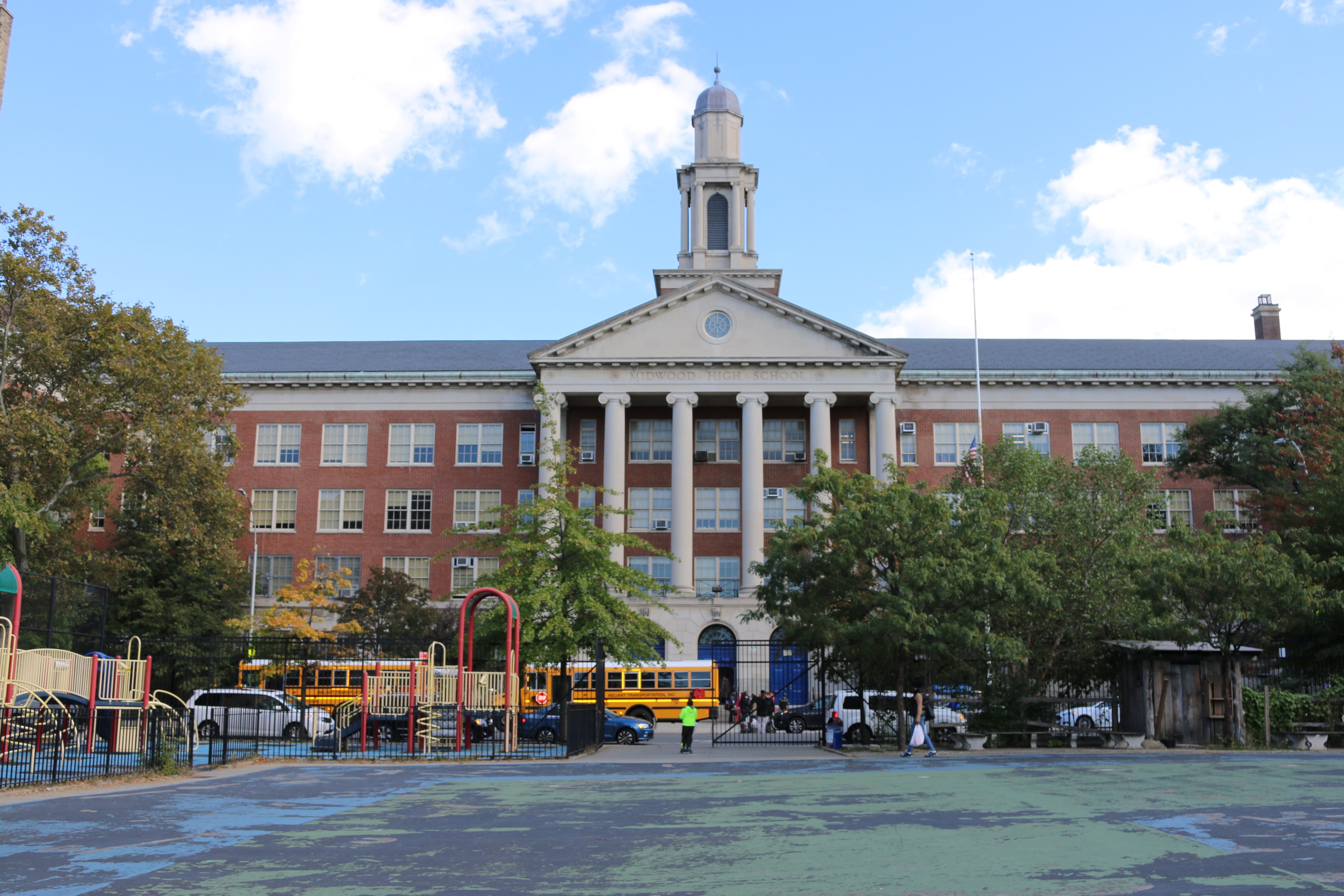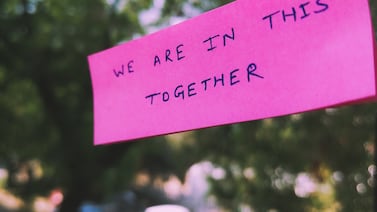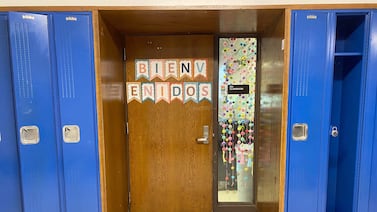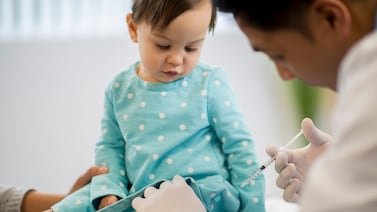This is part of an ongoing collaborative series between Chalkbeat and THE CITY investigating learning differences, special education and other education challenges in city schools.
When students begin returning to their school buildings next week, some of them might be in for a surprise: Instead of being guided through lessons by the teacher in front of them, they will be asked to log on to virtual classes instead.
A number of high schools across the city are moving all of their instruction online, even when students come to school in person. The move is an effort to resolve a series of interlocking problems: a staffing crunch, constantly changing numbers of students who are opting for fully remote learning, and even making sure students don’t have to leave their classrooms and risk spreading the coronavirus in the hallways.
Instead, a teacher will be assigned to the classroom solely to provide guidance and oversight as students work on their devices, educators said. It’s not clear exactly how many schools are opting for this model, and the education department didn’t provide a figure.
But THE CITY and Chalkbeat identified a half-dozen schools that collectively serve more than 10,000 students — including Stuyvesant High School in Manhattan, and Edward R. Murrow and Midwood high schools in Brooklyn — that are resorting to the unusual model.
Some school leaders said they felt like there were few other viable options.
“Functioning schools are doing this where they’re broadcasting [lessons] out, and if the kid happens to be in the school — great,” said one Manhattan principal who requested confidentiality to speak freely about school reopening hurdles. “When they’re in our building, they’re either tuning into the same broadcast that a kid at home would be, or pulling down the same assignments to work independently.”
The principal added that many schools fell into this model by default, since it was the only option that worked based on staffing needs.
Manhattan’s New Design High School settled on a similar model, which school officials said comes with major advantages. It doesn’t require them to increase dramatically the number of staff they need, allows schools to switch seamlessly to fully remote learning if the coronavirus surges, and enables them to keep students in single 9- to 11-student “bubbles” throughout the day — to avoid the risks of over 100 students cramming into hallways with little room to distance.
“Everything they’ll be doing is digital and they’ll be able to connect with their classmates online,” said Melissa Dorcemus, a teacher at the school who helped devise their reopening plans.
Over 60% of the school’s students have already opted for online-only learning. “We made the decision first on health and safety,” she said.
The model does have drawbacks. Classrooms will include a mix of students who are all logged on with different teachers either elsewhere in the building or are working from home because they have health accommodations, which means technology snafus like faulty devices or slow internet speeds could disrupt learning. It will also require a lot of students at home: regularly logging in at appointed times instead of working through lessons on their own.
And while Dorcemus said the school has not yet heard complaints from parents about the setup, there are pedagogical trade offs when relying on virtual instruction. “There is a little bit of magic that is lost in the teaching that is hard to transfer online,” she said.
The Department of Education had asked for schools to have one set of teachers for students who are learning 100% remotely from home, and two additional teachers for each portion of the blended learning model — one for in-class instruction, in which most students attend school between one and three days a week, and a separate remote teacher on the other days.
“There’s nobody living up to what they asked us to do because what they asked us to do is not mathematically possible,” the Manhattan principal said. “It’s crazy. It’s absolutely crazy.”
Teacher shortage
Earlier this week, Mayor de Blasio said the city had identified 2,000 education department administrators for reassignment as classroom instructors to serve in schools that were short on teachers.
But that number was well shy of the roughly 10,000 teachers that the principals union said would be needed to implement the city’s plans for reopening schools.
Late Tuesday, the education department relaxed rules that mandated that students in the blended learning model receive a minimum amount of live instruction when they’re learning from home. In theory, students in the blended model could receive as little as one day of live instruction each week.
Schools that have embraced a virtual model pointed out that they won’t need to scale back the amount of live instruction students receive, despite the education department allowing them to, since all students will already be working as if they were remote.
But Michael Mulgrew, president of the city’s teachers union, has raised concerns about teachers streaming their in-person lessons to remote students simultaneously.
“I know in a lot of schools they keep telling teachers that we’re going to put a camera in your classroom — that is the last thing anyone wants,” Mulgrew recently told reporters. “Frankly it’s useless because the teacher has to deal with the kids in the classroom and all you’ll see is the teacher walking in and out.”
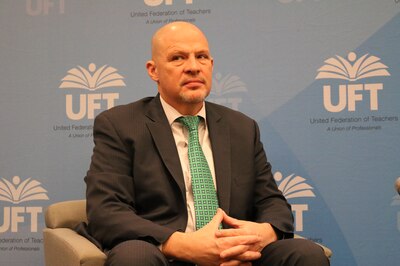
At Murrow High School in Brooklyn, which typically has an enrollment of about 4,000 students, AP Calculus teacher Eliot Weiss said a surge this week in the number of teachers who were exempted from having to teach in person led the school to go the remote route for all students.
He noted that about half the teachers in the math department were slated to work from home, and questioned whether students with commutes of as long as 90 minutes would continue to make the trip to school just to receive the same instruction they can get at home.
“I’m not sure what the advantage is of them going to school,” said Weiss, who also coaches the chess team.
Late Changes
A teacher at FDR High school in Brooklyn said teachers there learned on Wednesday afternoon that they too were moving to all-remote instruction for all but their most vulnerable students.
“As of September 29, blended students will be programmed into the Auditorium, Cafeteria or Gyms A and B. They will participate in Remote Instruction from there,” the notice said. “Staff members who are in our building will be teaching remotely from classrooms.”
The email notes an initial exception for students who are learning English — for whom live instruction can better assess their proficiency and offer support — while students with significant disabilities will still have in-person classes five days per week.
Midwood High School in Brooklyn, according to online documents, and Stuyvesant High School in Manhattan are similarly providing their in-classroom students solely with remote instruction.
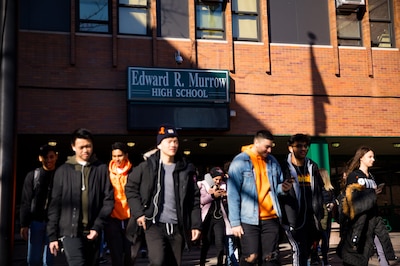
Stuyvesant Principal Seung Yu said he anticipates students will feel “both nervous and excited about school” given the unusual circumstances.
“No one said this school year would be easy or similar to what we’ve ever experienced before, but the Stuyvesant school community is ready to see and learn alongside one another in the building we all know and love,” he said.
Department of Education officials noted that students learning remotely while at school will benefit from the social interactions with their peers and teachers, and may end up doing socially distanced group work as well.
“Our goal is to have in-person instruction for our in-person students daily and this is happening in the vast majority of schools,” said education department spokesperson Danielle Filson. “Schools will offer students rich courses using both in-person and remote methods, and may make adjustments over the fall as their staffing levels increase.”
‘This is not working’
City Council Education Chair Mark Treyger said the staffing crunch was particularly impacting high schools because they have more specific certification requirements for their teachers than do elementary schools.
He said Murrow and FDR high schools in Brooklyn, which together serve close to 8,000 students, were still short of as many as 80 and 90 teachers, respectively.
“This is a sloppy and irresponsible attempt at crisis management. This is not education,” said Treyger, a former high school social studies teacher. “This is not working.”
Amy Zimmer contributed.


